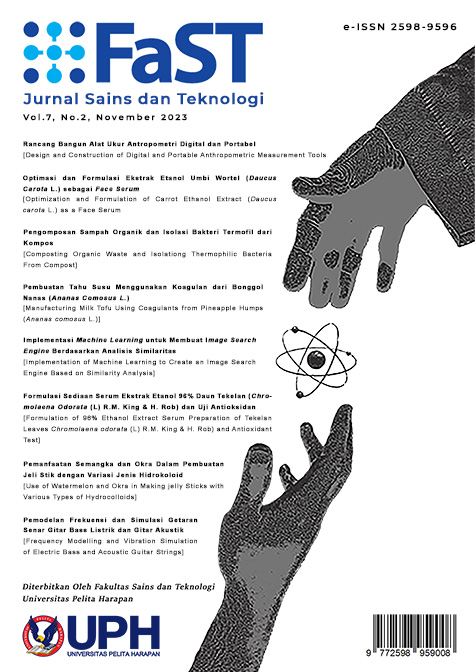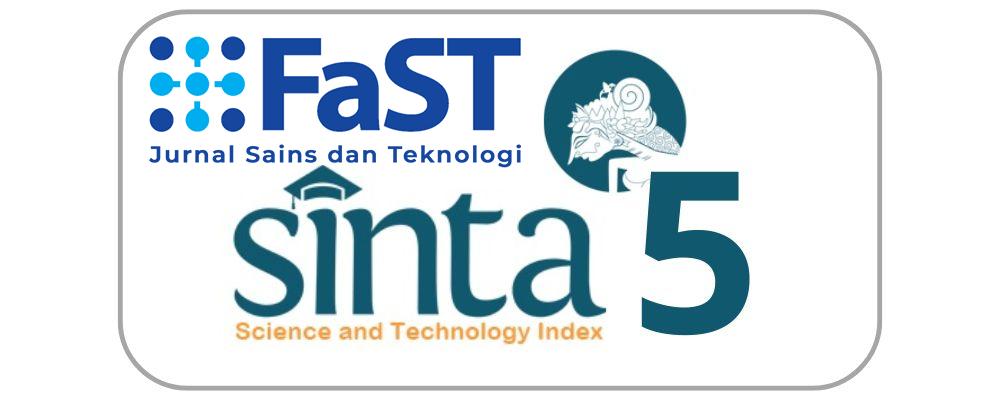IMPLEMENTASI MACHINE LEARNING UNTUK MEMBUAT IMAGE SEARCH ENGINE BERDASARKAN ANALISIS SIMILARITAS [IMPLEMENTATION OF MACHINE LEARNING TO CREATE AN IMAGE SEARCH ENGINE BASED ON SIMILARITY ANALYSIS]
DOI:
https://doi.org/10.19166/jstfast.v7i2.7592Keywords:
convolutional neural network, firebase, image search engine, image similarity, mobile applicationAbstract
The development of technology makes it easier to search for something on the internet. Based on data in 2022, there will be more than 1 billion Google users worldwide. This data proves the importance of search engines for internet users. However, in general, search engine searches use keywords. This research aimed to produce image search engines for searching. The image search engine utilizes a Convolutional Neural Network, namely VGG-16, which would compare the similarity of the input image to all images in the database by comparing the neurons in the image. Image search engine performance was measured based on the accuracy and sequence of image output. Accuracy was obtained with a weighting system from 5 search result images produced by the image search engine. Mobile phone applications were used to improve the quality of images used for searching. The application would capture images or take images through the gallery then upload them to Firebase and be used to search by image search engines. From the research conducted, it was found that changing the angle had the greatest impact on decreasing accuracy values when compared to 3 other factors: color, background and image quality. The decrease in accuracy due to the influence of angle, color, backround,, and image quality was 96.25%, 0%, 22.5%, and 68.75%, respectively. The images from cellphone application were proven to have higher accuracy (95.32% ) than the images captured with webcam (86.67%). The increase in accuracy emphasizes that the influence of image quality and the angle of the image used to search influences search results. The specifications of the cellphone camera are 64 Megapixels, while the webcam camera is 2 Megapixels.
Bahasa Indonesia Abstract:
Berkembangnya teknologi memberikan kemudahan untuk mencari sesuatu dalam internet. Berdasarkan data pada tahun 2022 lebih dari 1 milliar pengguna google di seluruh dunia. Data tersebut membuktikan bahwa pentingnya search engine bagi pengguna internet. Namun pada umumnya, pencarian search engine memanfaatkan kata kunci. Penelitian ini bertujuan untuk menghasilkan image search engine untuk pencarian. Image search engine memanfaatkan Convolutional Neural Network yaitu VGG-16 yang membandingkan kemiripan gambar input dengan semua gambar pada database dengan membandingkan neuron-neuron pada gambar. Performa image search engine diukur berdasarkan akurasi dan urutan keluaran gambar. Akurasi didapatkan dengan sistem pembobotan dari 5 gambar hasil pencarian yang dihasilkan oleh image search engine. Aplikasi handphone dimanfaatkan untuk meningkatkan kualitas gambar yang digunakan untuk pencarian. Aplikasi akan menangkap gambar atau mengambil gambar melalui gallery kemudian diunggah ke firebase dan digunakan untuk mencari oleh image search engine. Dari penelitian yang dilakukan didapatkan bahwa perubahan angle memberikan dampak yang paling besar terhadap penurunan nilai akurasi jika dibandingkan dengan 3 faktor lainnya: warna, background, dan kualitas gambar. Penurunan akurasi yang didapatkan akibat pengaruh angle, warna, bakcground, dan kualitas gambar masing-masing sebesar 96,25%; 0%, 22,5%; dan 68,75%. Gambar dari aplikasi handphone terbukti memiliki akurasi lebih tinggi (95.32%) dari gambar hasil tangkapan webcam (86,67%). Peningkatan akurasi ini mempertegas bahwa pengaruh kualitas gambar dan angle pada gambar yang digunakan untuk mencari mempengaruhi hasil pencarian. Spesifikasi dari kamera handphone adalah 64 Megapixels, sedangkan kamera webcam 2 Megapixels.
References
Bogdanchikov, A., Zhaparov, M., & Suliyev, R. (2013). Python to learn programming. Journal of Physics: Conference Series, 423(1), 012027. https://doi.org/10.1088/1742-6596/423/1/012027
Dongare, A., Kharde, R. R., & Kachare A. D. (2012). Introduction to artificial neural networks. International Journal of Engineering and Innovative Technology, 2(1), 189-194.
Ganesh, K. S. (2020). What’s the role of weights and bias in a neural network? Retrieved July 25, 2022 from https://towardsdatascience.com/whats-therole-of-weights-and-bias-in-a-neural-network-4cf7e9888a0f
Gowrishankar, S., & Veena, A. (2018). Introduction to python programming. CRC Press. https://doi.org/10.1201/9781351013239
Hijazi, S., Kumar, R., & Rowen, C. (2015). Using convolutional neural networks for image recognition. Retrieved October 20, 2022 from https://site.eet-china.com/webinar/pdf/Cadence_0425_webinar_WP.pdf
Purcell, K., Brenner, J., & Rainie, L. (2012). Search engine use 2012. Retrieved May 25, 2022, from https://www.ris.org/uploadi/editor/1341041853PIP_Search_Engine_Use_2012.pdf
Sini, M. A., & Abuata, B. A. (2013). Web image search engine evaluation. International Arab Journal of Information Technology, 3(2), 90-98.
Smyth, N. (2017). Firebase essentials - Android edition. Payload Media.
Srinath, K. R. (2017). Python-the fastest growing programming language. International Research Journal of Engineering and Technology, 4(12), 354-357.
Zafar, A., Aamir, M., Nawi, N. M., Arshad, A., Riaz, S., Alruban, A., Dutta, A. K., & Almotairi, S. (2022). A comparison of pooling methods for convolutional neural networks. Applied Sciences, 12(17), 8643. https://doi.org/10.3390/app12178643
Downloads
Published
Issue
Section
License
“Authors who publish with this journal agree to the following terms:
1) Authors retain copyright and grant the journal right of first publication with the work simultaneously licensed under a Creative Commons Attribution License (CC-BY-SA 4.0) that allows others to share the work with an acknowledgement of the work's authorship and initial publication in this journal.
2) Authors are able to enter into separate, additional contractual arrangements for the non-exclusive distribution of the journal's published version of the work (e.g., post it to an institutional repository or publish it in a book), with an acknowledgement of its initial publication in this journal.
3) Authors are permitted and encouraged to post their work online (e.g., in institutional repositories or on their website). The final published PDF should be used and bibliographic details that credit the publication in this journal should be included.”





